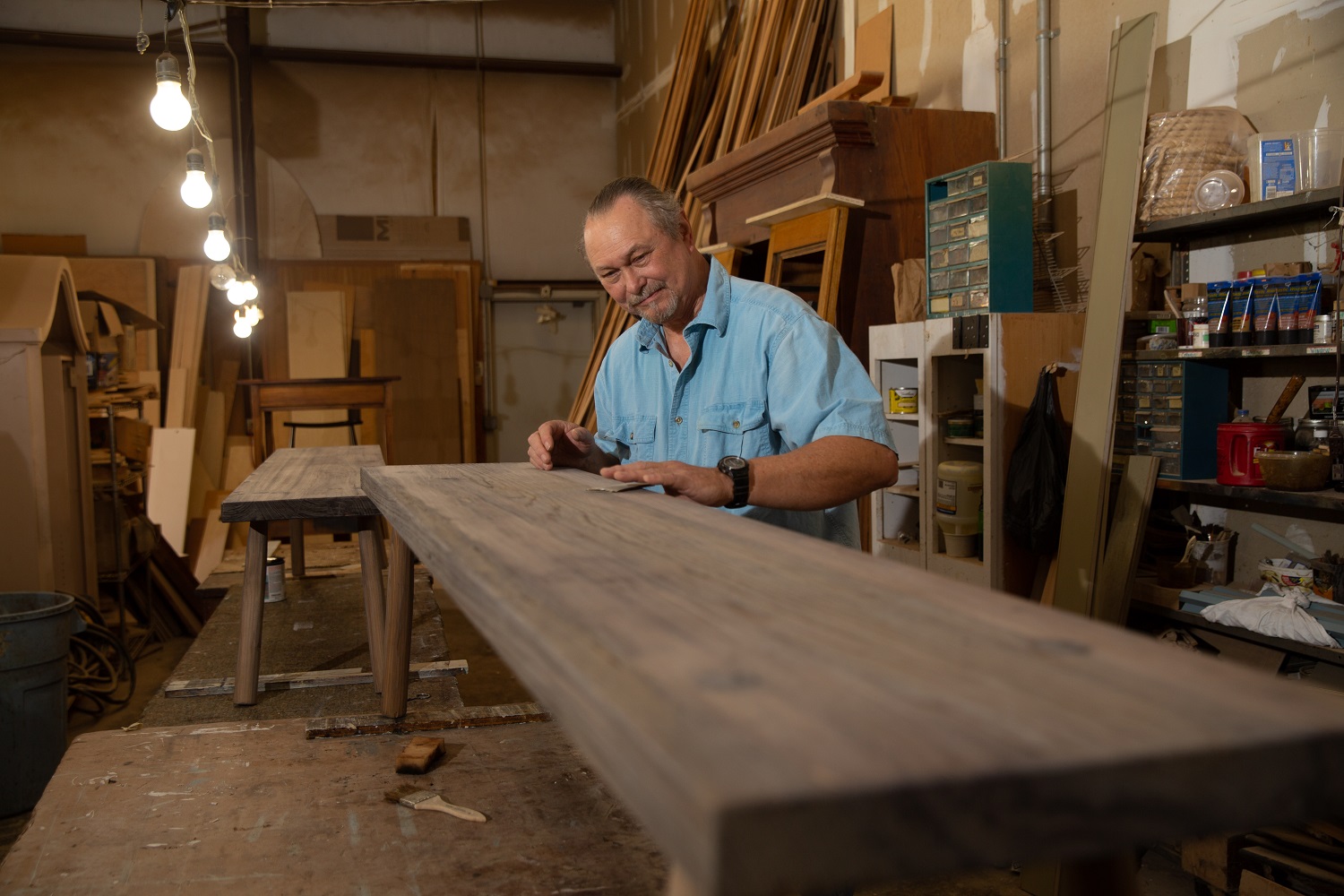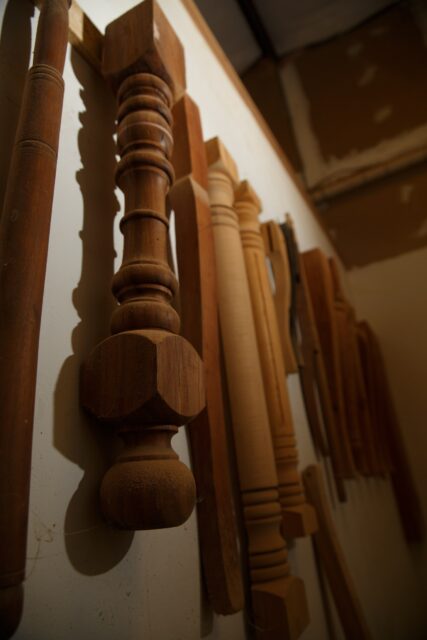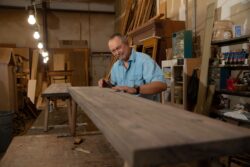Traditions in Wood
Cabinetmaker Greg Arceneaux brings artistry and heritage to his craft
Published: November 30, 2021
Last Updated: June 1, 2023

Photo by Brian Pavlich
Greg Arceneaux in his workshop.
Raised in Baton Rouge, Arceneaux found inspiration while living in Lafayette in the 1970s. Wandering amongst the trees, he wondered “what the woods looked like on the inside.” With its strong Acadian French heritage, Lafayette was not short on resources for someone looking to learn about eighteenth- and early nineteenth-century furniture making. In addition to pulling ideas from local material culture, digging into technical magazines—particularly Fine Woodworking—gave Arceneaux a well-rounded start to his now thirty-plus-year career.
As a craftsman Arceneaux remains faithful to the practices of two-hundred-year-old Louisiana cabinetmakers; his furniture designs originate from early Acadian and Creole forms, which, other than a few exceptions like the ladder-back chair and cabriole-leg table, have not been made the same way since the nineteenth century. His work, he said, is a kind of cultural preservation: “Furniture is a cultural artifact.” To Arceneaux it is a point of pride that he uses traditional eighteenth-century joinery and hand-rubbed oil finishes. And when working on old pieces, instead of “refinishing,” he prefers to “restore finishes.”
Arceneaux majored in sculpture and still uses his sculptural talent to craft aesthetically pleasing yet utilitarian furniture. With any piece he makes, his goal is to engage people with the unique history of the state and region. For some of his custom designs there are few or no historical examples to draw from; in those cases, Arceneaux said, “I have to use my knowledge of the design details to create an appropriate piece.”
A commission Arceneaux remembers well was a table and a set of twelve chairs for the Sala Capitular, the second-floor room at the Cabildo in New Orleans where, in 1803, representatives of Thomas Jefferson and Napoleon Bonaparte signed the Louisiana Purchase. After the 1988 fire at the Cabildo that destroyed hundreds of artifacts, including rare examples of eighteenth- and nineteenth-century furniture, the Louisiana State Museum decided to refurnish the Sala Capitular to the time of the Purchase. Curators used an inventory of the room’s contents to form the plan and sought out Louisiana craftsmen to reproduce the furniture. Members of the Louisiana Furniture Industry Association submitted bids, and Arceneaux won the commission for the table and chairs. The ladder-back, rush-seat chairs with a distressed wood finish closely resemble extant pieces from the period.
Wandering amongst the trees, he wondered “what the woods looked like on the inside.”
Occasionally, a client who needs to complete a set of chairs or have something built on a larger-than-normal scale will contact Arceneaux with a special request. With chairs he recognizes the necessity of scaling them appropriately for modern size while maintaining historical accuracy. For one connoisseur who has been collecting for thirty-plus years, Arceneaux built thirty-one chairs to match one he owned that had been on loan to the Smithsonian. By his matching the size and details well enough, he said, “No one can tell which is the original.”
Arceneaux’s historically inspired oeuvre also includes the “Live Edge” and “Hand Carved” collections. For his Live Edge pieces, he features the tree’s natural bark or edge as an element of the finished design. A Hand Carved armoire, rich in such decorative detail as a highly carved cornice or door panel, would be difficult for all but the most discerning eye to distinguish from its eighteenth-century French predecessor.
Arceneaux’s family was in the lower Mississippi River valley as early as 1705. His ancestor Michel Arceneaux was given a land grant on the river where Gramercy is today; later, when the Acadians arrived, they settled above there, along what became known as the Acadian (“Cajun”) coast. Eighteenth-century settlements up and down the Mississippi River, up to Missouri, and even into Canada, shared common languages and material culture.
When he started out in the 1970s, Arceneaux used recycled materials and pieces salvaged from old houses. He remembers practicing his craft with tropical hardwoods that he sourced from old motorcycle and piano crates. Today, and for most of his career, he has used primarily indigenous woods, though, since New Orleans has been a port for more than two hundred years, even in the eighteenth and nineteenth centuries a variety of woods were readily available for local craftspeople. He primarily uses higher-grade hardwoods like cherry, walnut, and mahogany. For chairs, pecan and hickory are preferred. Cypress was plentiful until the early twentieth century and mostly was used for utilitarian pieces like kitchen tables, stairs, and doors. Old-growth cypress—aged up to fifteen hundred years—was last harvested in the 1920s, so the cypress being harvested now is only about one hundred to two hundred years old. New cypress contains lower levels of cypresene oil, whose build-up made the old-growth wood resistant to bugs and rot.
Over the years, Arceneaux has tweaked his techniques, but mostly he has stuck with what works and what has worked for centuries. His strong ties to the communities in which he and his family have lived for generations, his study of traditional furniture-making methods, and his commitment to combining the useful and the beautiful over a long career have resulted in the dissemination of knowledge about Louisiana’s heritage through his craft.
A native of Mobile, Alabama, Katie Burlison is curator at the Hermann-Grima + Gallier Historic Houses in the French Quarter. She holds an MA in decorative arts, design history, and material culture from the Bard Graduate Center in New York City and a BA in French from the University of Virginia. Katie enjoys spending time with family and cherishes the unique cultural experiences of the Crescent City.

